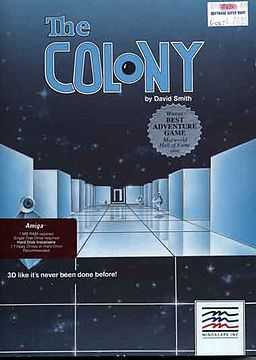The Colony (video game)
| The Colony | |
|---|---|
 | |
| Developer(s) | David Alan Smith |
| Publisher(s) | Mindscape |
| Designer(s) | David Alan Smith |
| Engine | FLY-BY Environment Simulator |
| Platform(s) | Macintosh, DOS, Amiga |
| Release date(s) | 1988: Macintosh, DOS 1990: Amiga |
| Genre(s) | First-person shooter, Adventure, Puzzle |
| Mode(s) | Single-player |
| Distribution | Floppy disk |
The Colony is a first-person shooter developed by David Alan Smith. It was published by Mindscape.
The 1988 Macintosh release came in two versions, one in color and one with black-and-white graphics. The DOS version, released the same year, was available in black-and-white only. The 1990 Amiga version was in color.
Previous first-person perspective games of the era used precomputed views, such as The Sentinel, or fixed-perspective graphics, such as Phantom Slayer. The Colony was one of the first games of its kind to let the player move freely while rendering graphics in real time. It was also the first 3D game to let the player drive a vehicle.
Plot
The player takes the role of a marshal responding to a distress call from a research colony. After crash-landing on the planet, the marshal must repair their damaged ship, investigate the colony, and eventually discover and stop an alien race plotting to take over the universe.[1]
Development
Instead of a 360-degree circle, The Colony used 256 "pseudo-degrees" which allowed the game engine to rotate the player's perspective using only one byte of data. Bit-map graphics were drawn using MacPaint, while 2D images such as doors, letters, and the Apple logo were crafted using the game engine.
It is interesting to note that at the time of the game's development, the standard method of programming for the Macintosh was to use an Apple Lisa. Development tools for the Macintosh did not exist when the Macintosh was initially released. David Alan Smith completed the first scenes of The Colony with a C compiler ported to the Macintosh by Softworks. Those first scenes were developed on a Macintosh with only 128KB of RAM and a single floppy disk drive. Eventually, development tools were made available on the Macintosh, allowing Mr. Smith to complete his work using the Megamax C and Lightspeed C compilers—on a Macintosh upgraded to 512KB of RAM and a 20MB hard drive.
Reception
Computer Gaming World commented favorably on the combination of both action and adventure elements, but noted the immense difficulty of the game.[1] Amiga Format echoed this feeling by giving it a 51% score and complaining that "the graphics are sketchy and unrealistic and the gameplay is repetitive and frustrating".[2] Macworld named it Best Adventure Game of the Year in 1988, however, and in 2000 listed it as one of The Top Ten Mac Gaming Thingies of the Last 1,000 Years.[3] Orson Scott Card, who disliked The Colony, wrote in Compute! "How did this game ever become a "game of the year"? Only because it originally appeared on the game-poor Mac", with excellent graphics that accompanied "a very limited puzzle game that became so annoying and confining" that he and his son gave up. Card stated that the game arbitrarily punished players for exploring, giving as example immediately dying from picking up cigarettes.[4]
References
- ↑ 1.0 1.1 Roberts, Alan (February 1989). "The Colony". Computer Gaming World. pp. 14, 56.
- ↑ Evans, Maff (June 1990). "The Colony". Amiga Format. p. 66.
- ↑ Breen, Christopher (Jan 2000). "The Top Ten Mac Gaming Thingies of the Last 1,000 Years". MacWorld. p. 63.
- ↑ Card, Orson Scott (June 1989). "Light-years and Lasers / Science Fiction Inside Your Computer". Compute!. p. 29. Retrieved 11 November 2013.
External links
- My Colony Memoir on David Alan Smith's blog
- The Top Ten Mac Gaming Thingies of the Last 1,000 Years at Macworld
- Amiga Format review of The Colony at the Amiga Magazine Rack
- The Colony at MobyGames